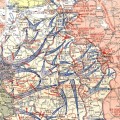
1941-2014: Past Reaching into Present. Professor of History Marta Dyczok, from Kyiv.
With war on their territory, perhaps many Ukrainians were not thinking about history on June 22

That day, the anniversary of Germany’s attack on the USSR in 1941, their President Petro Poroshenko visited the current war zone. He placed a wreath at a memorial commemorating those killed in the past, and turned his attention to the present.
Announcing a unilateral cease fire, he appealed to those shooting to lay down their arms so that peace could be restored. “Both of my grandfathers died during World War II fighting in the Red Army,” he told reporters, and expressed fears that a new World War might be brewing.
As most Ukrainians hope for peace, the past continues to cast a heavy shadow over the present. The way history was written and taught in the Soviet era distorted the facts, created a warped historical memory in Ukraine and Russia. Those who did not experience events or have access to independent sources of information are struggling to come to terms with what actually happened and understand why. Some continue to believe in old myths, constructed by all sides.
For decades, people in the Soviet Union were told that the war started on the 22nd of June in 1941. That day Germany launched Operation Barbarossa and invaded the USSR. What wasn’t talked about within the USSR, was that the war had actually started in September of 1939, after the Soviet Union and Germany agreed to divide Eastern Europe amongst themselves in the Molotov-Ribbentrop Pact, and invaded Poland.
This led to the most widespread war in history. It directly involved more than 100 million people, from more than 30 countries, and caused between 50 and 85 million fatalities. We may never know the exact figure, but demographers and historians continue to work with statistics and archives. A recent study by Russian historian Vadim Erlikman shows that Ukraine lost over 16% of its population as a result of the war. Of the estimated 6,850,00 killed, 5,200,000 were civilians.
During this conflict a partisan movement sprung up in Western Ukraine that congealed into the Ukrainian Insurgent Army. A significant portion of the fighters came from the Stepan Bandera-led part of the Organization of Ukrainian Nationalists. Their aim was to create an independent Ukraine, but their ideology was right wing and there are some questionable aspects to their activities.
They continued to fight for independence into the 1950s, and posed a serious threat to the Soviet myth of unity. While demonized in the official Soviet historical narrative, they created their own heroic one.
Today, Russians are being told by their mass media that nationalist-fascists have seized power in Ukraine, that Russians and Russian speakers are being threatened and killed by right wing anti-Semitic banderites, and that the Ukrainian government is killing its own people.
These media messages are also being sent into Ukraine. They seem deliberately framed in historical terms to open up old wounds, enflame divisions, and incite hatred.
“The way to stop this war is to stop it in people’s heads,” Donetsk journalist Serhiy Harmash said recently. As a historian I know nothing is ever black or white. But if people take a clear look at the past, confront the truths, and the lies, it may help convince those being spurred to kill, that they’d be better off building a future.


